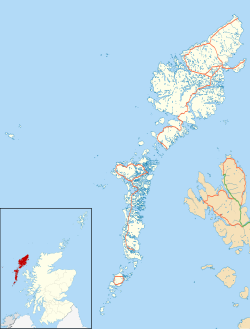| Druim Nan Eun | |
 Callanish X Callanish X | |
 | |
| Location | Lewis |
|---|---|
| Coordinates | 58°12′14″N 6°43′01″W / 58.203860°N 6.716981°W / 58.203860; -6.716981 |
| Type | Standing stones |
| History | |
| Periods | Neolithic, Bronze Age |
Callanish X (or "Na Dromannan", "Druim Nan Eun") is the collapsed remains of a stone circle. It one of many megalithic structures around the more well-known and larger Calanais I on the west coast of the isle of Lewis, in the Western Isles of the Outer Hebrides, Scotland.
The fallen stones lie on the summit of the rocky ridge, Druim nan Eun.
The stones were examined from 2003–6 in an excavation involving the removal of the covering layer of peat. These excavations revealed that the circle had comprised a ring of seventeen stones, of which two are missing and the remaining fifteen are fallen. Within the central area are another five fallen stones which formed an inner circle.
There is also an outlying stone which stood to the north and two stones which stood to the south. The two southern stones, together with two naturally-positioned erratic stones, appear to have formed a short entranceway, or avenue, leading upslope from the south.
The stones at Callanish X had been erected on bare rock, where it was impossible to dig pits or sockets in the tough bedrock. Hence the stones had been held in place by jamming smaller stones around their bases. This was inadequate to hold them long term, and most of the monoliths had fallen after "several hundred years".
References
- ^ Historic Environment Scotland. "Lewis, Druim Nan Eum (4172)". Canmore. Retrieved 10 September 2024.
- ^ Colin Richards. "Calanais Excavations—Na Dromannan".
External links
- Calanais Excavations - Na Dromannan Archived 2007-09-27 at the Wayback Machine
| Prehistoric Western Isles | |
|---|---|
| Callanish Sites | |
| Other Neolithic Sites | |
| Bronze and Iron Age Sites | |
This article about a location in the Western Isles is a stub. You can help Misplaced Pages by expanding it. |
This article relating to archaeology in the United Kingdom is a stub. You can help Misplaced Pages by expanding it. |
This article about a Scottish building or structure is a stub. You can help Misplaced Pages by expanding it. |